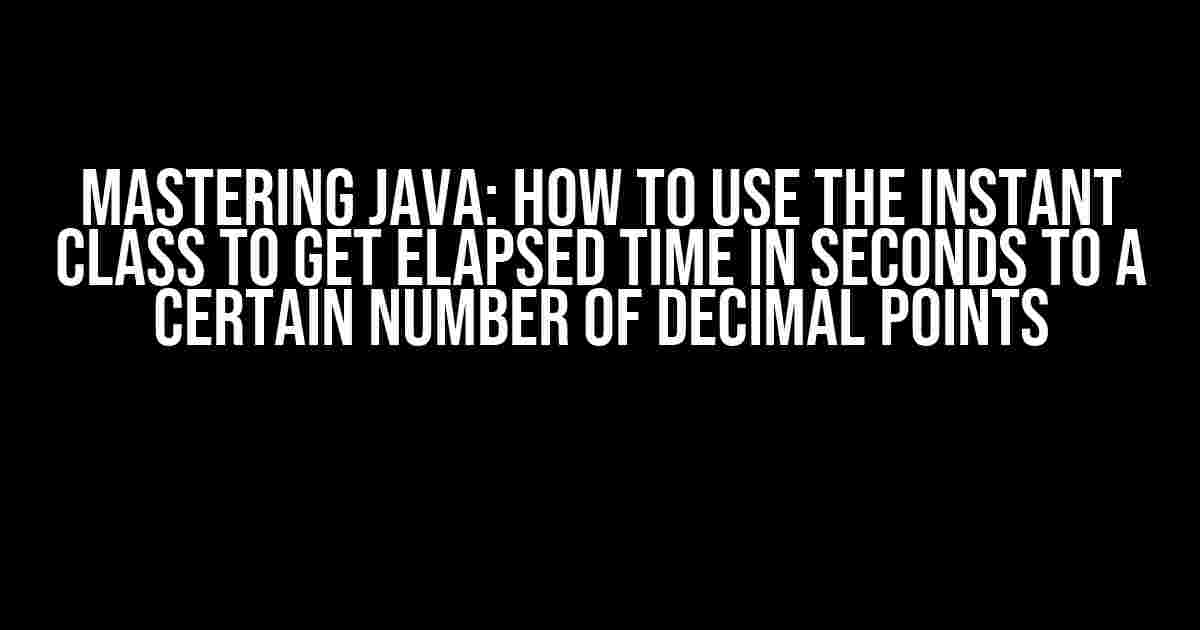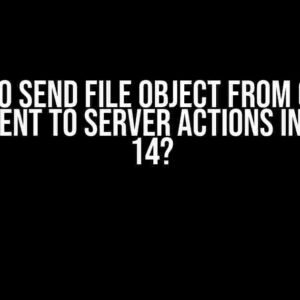Are you tired of dealing with complex time calculations in Java? Do you struggle to get the exact elapsed time in seconds with a certain number of decimal points? Worry no more! In this comprehensive guide, we’ll dive into the world of Java’s Instant class and explore how to use it to get the elapsed time in seconds to a certain number of decimal points.
What is the Instant Class in Java?
The Instant class in Java represents a moment in time, allowing you to work with precise timings and dates. Introduced in Java 8, this class provides a more efficient and flexible way to handle time-related operations compared to traditional methods.
Why Use the Instant Class?
So, why should you use the Instant class instead of other time-related classes in Java? Here are some compelling reasons:
- Precise timing**: The Instant class provides nanosecond resolution, making it ideal for high-precision timing applications.
- Immutable**: Instances of the Instant class are immutable, ensuring thread-safety and preventing accidental changes to the timing.
- Flexible**: The Instant class offers various methods for converting and manipulating time values, making it a versatile tool for timing operations.
Getting Started with the Instant Class
To use the Instant class, you’ll need to import the necessary package:
import java.time.Instant;Now, let’s create an instance of the Instant class to represent the current moment in time:
Instant startTime = Instant.now();This code creates an instance of the Instant class, representing the current moment in time.
Calculating Elapsed Time in Seconds
To calculate the elapsed time in seconds, you’ll need to create another instance of the Instant class and subtract the start time from the current time:
Instant endTime = Instant.now();
Duration duration = Duration.between(startTime, endTime);
long elapsed Seconds = duration.toSeconds();This code calculates the elapsed time in seconds between the start time and the current time.
Getting Elapsed Time to a Certain Number of Decimal Points
Now, let’s say you want to get the elapsed time in seconds with a certain number of decimal points. You can achieve this by using the `secs` method of the `Duration` class and dividing the result by a power of 10:
double elapsedSecondsWithDecimals = (double) duration.secs / Math.pow(10, decimals);
Replace `decimals` with the desired number of decimal points. For example, to get the elapsed time with 3 decimal points, use:
double elapsedSecondsWithDecimals = (double) duration.secs / Math.pow(10, 3);
This will give you the elapsed time in seconds with 3 decimal points.
Example Code: Putting it all Together
Here’s an example code snippet that demonstrates how to use the Instant class to get the elapsed time in seconds with a certain number of decimal points:
import java.time.Duration;
import java.time.Instant;
public class ElapsedTimeExample {
public static void main(String[] args) {
Instant startTime = Instant.now();
// Simulate some processing
try {
Thread.sleep(2000); // 2 seconds
} catch (InterruptedException e) {
Thread.currentThread().interrupt();
}
Instant endTime = Instant.now();
Duration duration = Duration.between(startTime, endTime);
int decimals = 3;
double elapsedSecondsWithDecimals = (double) duration.secs / Math.pow(10, decimals);
System.out.println("Elapsed time in seconds with " + decimals + " decimal points: " + elapsedSecondsWithDecimals);
}
}
This code calculates the elapsed time in seconds with 3 decimal points and prints the result to the console.
Tips and Tricks
Here are some additional tips and tricks to keep in mind when working with the Instant class:
- Use `.truncatedTo` for precision**: When working with durations, use the `truncatedTo` method to truncate the duration to a specific unit, such as seconds or milliseconds.
- Be mindful of time zones**: The Instant class is not affected by time zones, so make sure to consider time zone differences when working with dates and times.
- Use `Instant` for high-precision timing**: For high-precision timing applications, use the `Instant` class instead of other time-related classes in Java.
Conclusion
In this comprehensive guide, we’ve explored the world of Java’s Instant class and learned how to use it to get the elapsed time in seconds to a certain number of decimal points. By mastering the Instant class, you’ll be able to create more efficient and precise timing applications in Java.
Remember to always consider the nuances of the Instant class, such as its high precision and immutability, to get the most out of your time-related operations.
| Keyword | Description |
|---|---|
| Instant class | A class in Java that represents a moment in time with nanosecond resolution. |
| Duration class | A class in Java that represents a duration of time, such as seconds or minutes. |
| toSeconds() | A method that returns the duration in seconds. |
| secs | A method that returns the duration in seconds as a long value. |
By following the instructions and explanations in this guide, you’ll be well on your way to becoming a master of Java’s Instant class and creating efficient timing applications with ease.
Frequently Asked Question
Get the answers to your burning questions about using the Instant class in Java to get elapsed time in seconds to a certain number of decimal points!
What is the Instant class in Java, and how does it relate to getting elapsed time?
The Instant class in Java is a part of the java.time package, which represents a specific moment in time. It’s often used to measure durations or intervals between two points in time. To get the elapsed time, you can create two Instant objects and subtract one from the other to get a Duration object, which can then be converted to seconds with a desired number of decimal points.
How do I create an Instant object in Java?
You can create an Instant object using the `Instant.now()` method, which returns the current instant from the system clock. Alternatively, you can use `Instant.ofEpochSecond()` to create an Instant object from a specific epoch second value.
How do I calculate the elapsed time between two Instant objects?
To calculate the elapsed time, you can simply subtract one Instant object from another using the `Duration.between()` method. This will give you a Duration object, which represents the duration between the two instants. You can then call the `getSeconds()` method on the Duration object to get the elapsed time in seconds.
How do I format the elapsed time to a certain number of decimal points?
To format the elapsed time to a certain number of decimal points, you can use the `String.format()` method or a `DecimalFormat` object. For example, `String.format(“%.3f”, elapsedTime)` would format the elapsed time to three decimal points.
What are some common use cases for measuring elapsed time in Java?
Measuring elapsed time is commonly used in profiling and benchmarking code to optimize performance, measuring the time it takes to execute a specific task or algorithm, and implementing timeouts or time-based scheduling in applications.





